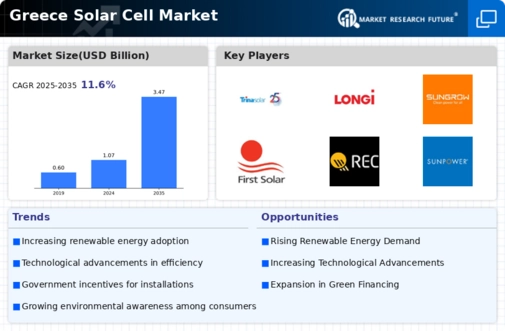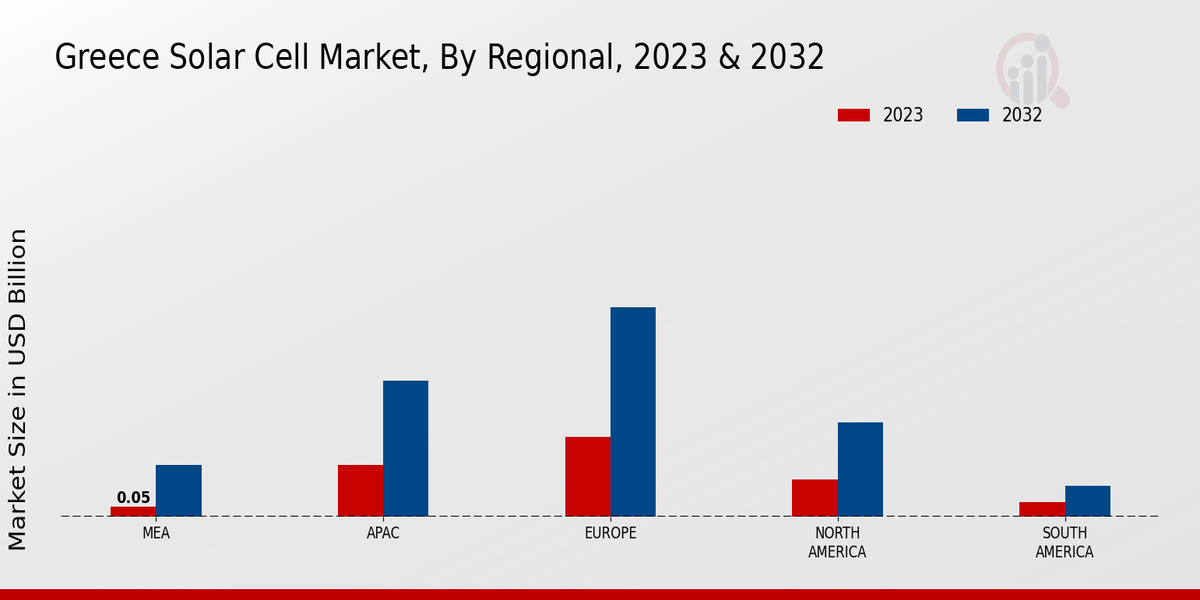Increasing Energy Prices
The rising cost of conventional energy sources is driving consumers and businesses to seek alternative energy solutions, thereby benefiting the Global Greece Solar Cell Market Industry. As energy prices continue to escalate, solar energy presents a cost-effective and sustainable alternative. This shift is particularly evident in Greece, where energy independence is a growing concern. The economic rationale for investing in solar technology is becoming increasingly compelling, as consumers recognize the long-term savings associated with solar installations. Consequently, this trend is expected to contribute to the market's growth and resilience in the coming years.
Market Growth Projections
The Global Greece Solar Cell Market Industry is poised for substantial growth, with projections indicating a market size of 1.07 USD Billion in 2024 and an anticipated increase to 3.47 USD Billion by 2035. This growth trajectory reflects a compound annual growth rate (CAGR) of 11.3% from 2025 to 2035, driven by various factors such as technological advancements, government incentives, and rising energy prices. The market's expansion is indicative of a broader shift towards renewable energy solutions, positioning solar energy as a pivotal component of Greece's energy landscape in the coming years.
Growing Environmental Awareness
Heightened environmental consciousness among consumers and businesses is a key driver of the Global Greece Solar Cell Market Industry. As awareness of the environmental impacts of fossil fuels increases, there is a growing preference for clean energy solutions. This shift in consumer behavior is prompting investments in solar technology, as individuals and organizations seek to reduce their carbon footprints. The alignment of consumer values with sustainable practices is likely to bolster the market's growth, as more stakeholders prioritize eco-friendly energy sources. This trend underscores the potential for the solar sector to thrive in an increasingly environmentally aware society.
Government Incentives and Policies
Supportive government policies and incentives play a crucial role in the expansion of the Global Greece Solar Cell Market Industry. The Greek government has implemented various initiatives, such as feed-in tariffs and tax benefits, to encourage solar energy adoption. These measures not only enhance the financial viability of solar projects but also stimulate private investments. As a result, the market is poised for robust growth, with projections indicating an increase to 3.47 USD Billion by 2035. This supportive regulatory environment fosters innovation and attracts both domestic and international players to the solar sector.
Rising Demand for Renewable Energy
The Global Greece Solar Cell Market Industry is witnessing a surge in demand for renewable energy sources, driven by increasing awareness of climate change and the need for sustainable solutions. Greece's commitment to achieving its renewable energy targets, including a goal of 35% of total energy consumption from renewables by 2030, aligns with global trends. This heightened focus on sustainability is likely to propel investments in solar technologies, contributing to the market's projected growth. By 2024, the market is expected to reach 1.07 USD Billion, reflecting a significant shift towards cleaner energy alternatives.
Technological Advancements in Solar Technology
Technological innovations are significantly influencing the Global Greece Solar Cell Market Industry. Advances in photovoltaic technology, such as bifacial solar panels and improved energy conversion efficiencies, are enhancing the performance and cost-effectiveness of solar installations. These developments are likely to attract more consumers and businesses to adopt solar solutions, thereby expanding the market. As the industry evolves, the integration of smart grid technologies and energy storage systems further enhances the appeal of solar energy. This trend suggests a promising trajectory for the market, with a projected CAGR of 11.3% from 2025 to 2035.























Leave a Comment